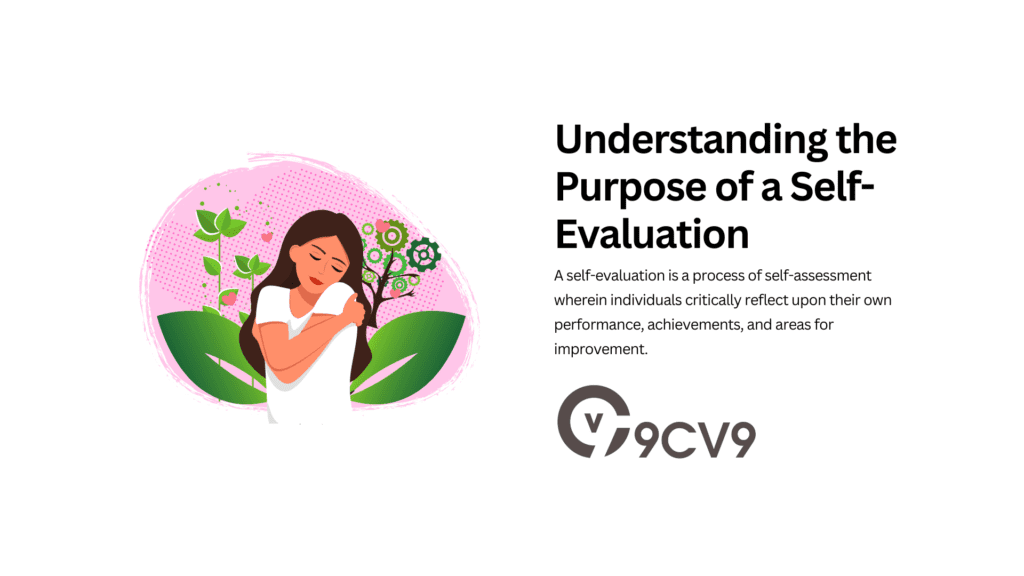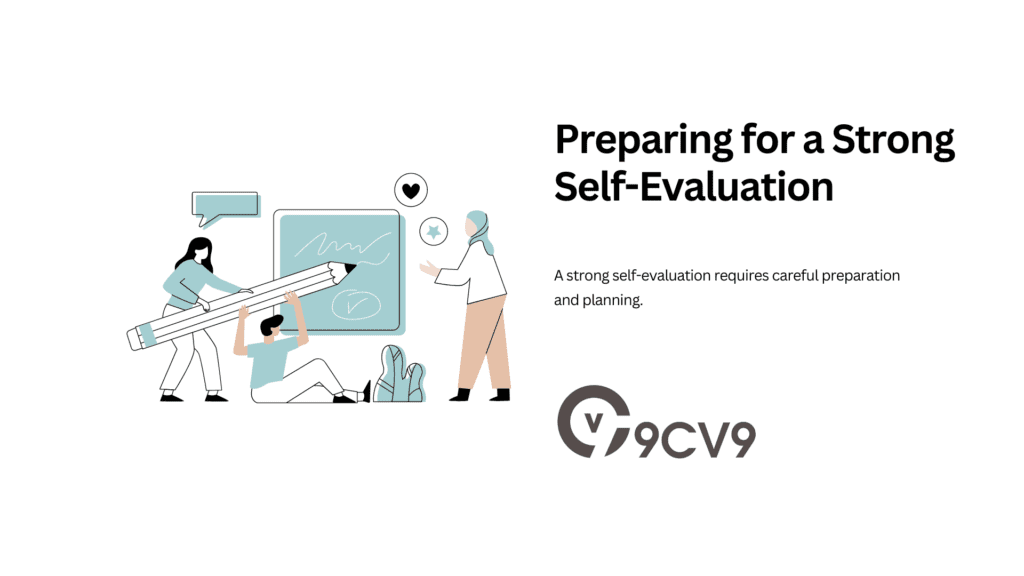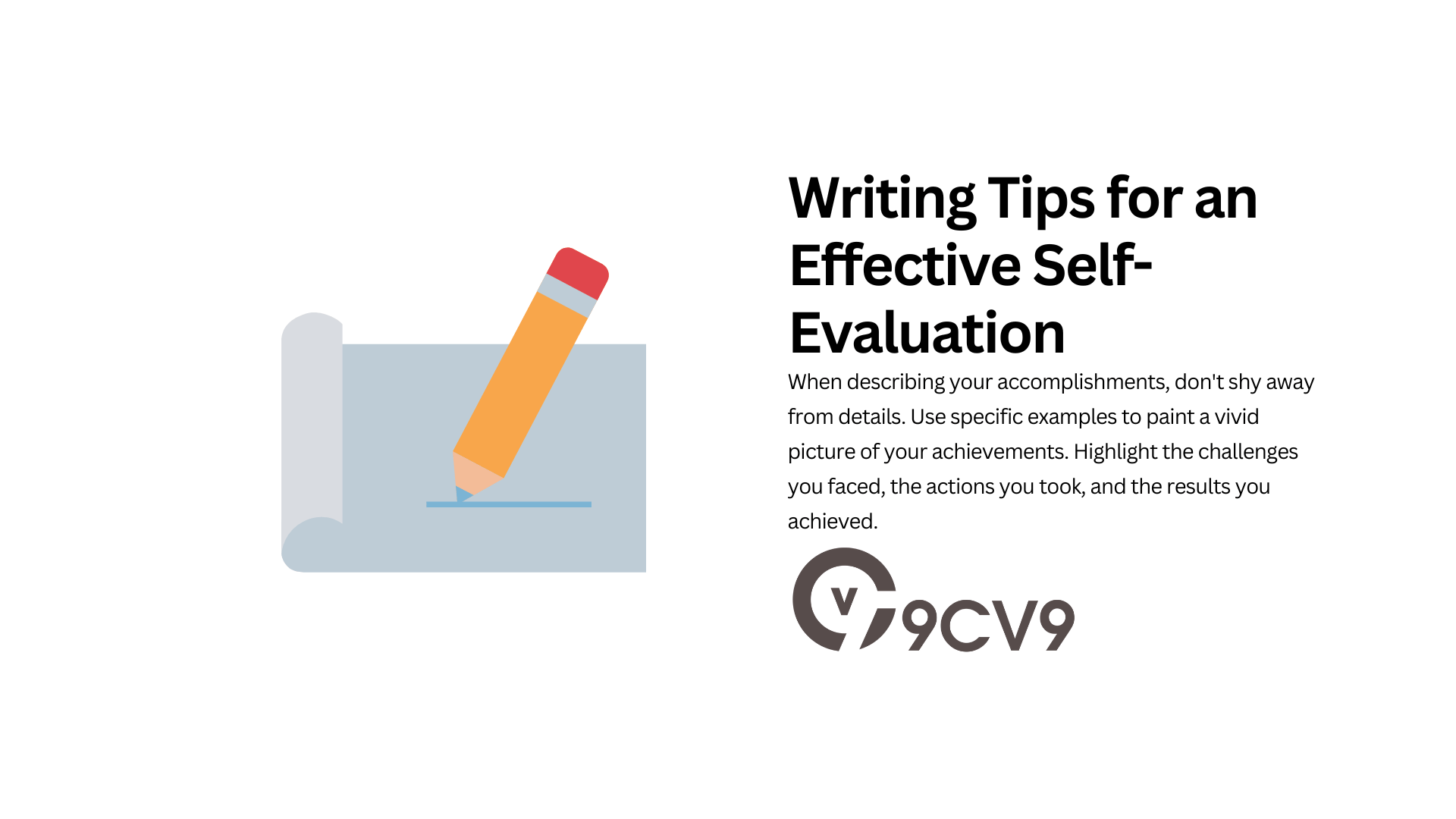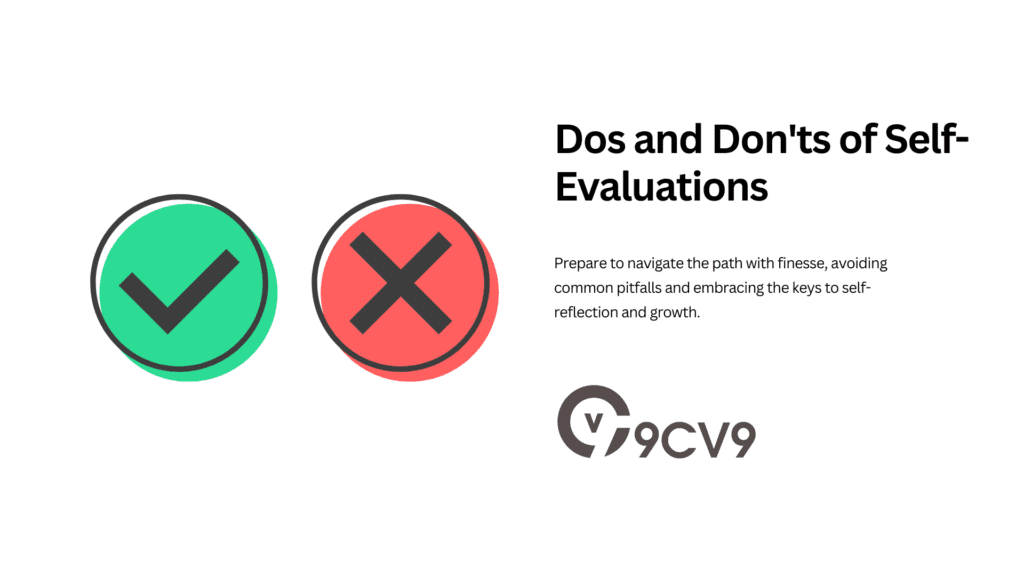Key Takeaways
- Learn the art of self-reflection: Discover how to effectively assess your performance, strengths, and areas for improvement in a self-evaluation.
- Structure for success: Master the art of organizing your self-evaluation to create a clear and impactful narrative that captivates the reader.
- Showcase your growth: Highlight your commitment to growth and development by discussing how you have learned from challenges and set new goals for yourself.
Welcome, dear readers, to the mystical realm of self-evaluation, where mirrors become our closest confidants and we juggle praise and criticism like seasoned circus performers.
Brace yourselves for a whimsical journey that combines humor, wisdom, and practical tips on how to master the art of writing a strong self-evaluation.
Get ready to discover your inner self-critic and unleash it with style.
Before we dive into the nitty-gritty of crafting a stellar self-evaluation, let’s take a moment to ponder its importance.
Picture this: you’re standing on the precipice of personal and professional growth, armed with the mighty pen and the power of introspection.
A well-crafted self-evaluation becomes your superhero cape, enabling you to reflect on your achievements, identify areas for improvement, and pave the way for future success.
It’s like a magical portal that lets you step back, assess your journey, and set sail for even greater horizons.
As any great performer knows, preparation is key to stealing the spotlight.
Similarly, a strong self-evaluation requires some groundwork.
Gather all the relevant information, dust off those old performance reviews, and take a nostalgic stroll down memory lane.
Reflect on your triumphs, challenges, and lessons learned.
Set clear goals and objectives for the evaluation period, but be sure to consult your crystal ball—or rather, seek feedback from trusted sources—to gain a broader perspective.
It’s time to unveil the script for your grand self-evaluation performance.
Begin with an engaging introduction, setting the stage for what’s to come.
Then, showcase your accomplishments and let the applause rain down upon you.
Remember, specificity is the key to winning hearts and minds, so sprinkle your narrative with vivid examples and measurable results.
But wait, the show must go on!
Acknowledge those areas where you stumbled, embracing the vulnerability of growth.
Like a trapeze artist soaring through the air, find your balance between honesty and optimism.
Finally, conclude your self-evaluation with a flourish, summarizing the highlights and reaffirming your commitment to continuous improvement.
To truly shine, your self-evaluation must be a masterpiece of clarity and precision.
Use the enchanted power of language to create a mesmerizing experience for your readers.
Employ the almighty “show, don’t tell” technique, using colorful anecdotes and tangible evidence to bring your accomplishments to life.
Remember, a dash of humor can be your secret weapon, captivating your audience while highlighting your personality.
However, beware the grammar gremlins and spelling specters that lurk in the shadows.
Proofread and format your self-evaluation with care, for even the most brilliant content can be overshadowed by misplaced commas or misspelled words.
Before we venture further into this article, we like to share who we are and what we do.
About 9cv9
9cv9 is a business tech startup based in Singapore with a strong presence worldwide.
With over six years of startup and business experience, and being highly involved in connecting with thousands of companies and startups, the 9cv9 team has listed some important learning points in this overview of how to do a strong Self-Evaluation for your performance review or job application.
If you are looking for a high-salary job or for a remote job, then hop over to 9cv9 Job Portal to find your next job and internship.
How to Write a Strong Self-Evaluation (Updated in 2023)
- Understanding the Purpose of a Self-Evaluation
- Preparing for a Strong Self-Evaluation
- Structuring Your Self-Evaluation
- Writing Tips for an Effective Self-Evaluation
- Dos and Don’ts of Self-Evaluations
- Finalizing Your Self-Evaluation
1. Understanding the Purpose of a Self-Evaluation

A self-evaluation, dear readers, is not just a mere ritual or an obligatory task imposed upon us by the realms of bureaucracy.
It is a profound opportunity for introspection, growth, and personal development.
So, let us delve into the very essence of self-evaluations and unravel their true purpose.
Defining Self-Evaluation
A self-evaluation is a process of self-assessment wherein individuals critically reflect upon their own performance, achievements, and areas for improvement. It serves as a vital tool for evaluating one’s progress, strengths, and weaknesses, both in personal and professional spheres. Think of it as a compass that guides you on your journey toward continuous improvement and success. According to some sources, Self-Evaluation has an impact on job satisfaction and turnover intention, mainly through the mediating role of intrinsic and extrinsic motivation.
Personal Growth and Reflection
Self-evaluations provide a unique platform for deep introspection and self-reflection. They offer a precious moment to pause, step back, and assess our own actions, decisions, and behaviors. By engaging in this process, we gain valuable insights into our strengths, values, and areas where we may need to direct our efforts for growth. It is like gazing into a mirror that reflects not just our physical appearance but also our innermost qualities.
Career Advancement and Performance Assessment
In the professional realm, self-evaluations play a pivotal role in assessing individual performance. They enable employees to showcase their accomplishments, highlight their contributions, and take ownership of their career progression. Self-evaluations often serve as a basis for performance reviews, promotions, and career development discussions. By crafting a strong self-evaluation, you can demonstrate your value to the organization, paving the way for future opportunities.
Setting Clear Goals and Objectives
One of the fundamental purposes of a self-evaluation is to set clear goals and objectives for personal and professional growth. By examining our past performance, we can identify areas where we excelled and those that require further attention. This process allows us to establish specific, measurable, achievable, relevant, and time-bound (SMART) goals that align with our aspirations. Through self-evaluations, we lay the foundation for our future endeavors, steering our paths towards success.
Enhancing Self-Awareness and Accountability
Self-evaluations foster self-awareness, a profound understanding of oneself, and one’s impact on others. By critically assessing our actions and behaviors, we become more conscious of our strengths and weaknesses. This heightened self-awareness empowers us to take responsibility for our actions, acknowledging both our triumphs and areas that need improvement. Through self-evaluations, we cultivate a sense of accountability, holding ourselves to a higher standard and driving our personal growth.
Encouraging Continuous Improvement
Self-evaluations are not meant to be static documents but living testaments to our journey of growth. They serve as a catalyst for continuous improvement by challenging us to explore innovative solutions, acquire new skills, and refine existing ones. By embracing feedback received during the evaluation process, we can adapt, learn, and evolve. Self-evaluations, therefore, become the cornerstone of our quest for excellence and advancement.
By understanding the true purpose of self-evaluations, we unlock their transformative potential. They become more than just a procedural obligation, but rather an opportunity to embark on a voyage of self-discovery, chart our own destinies, and sculpt the best versions of ourselves. So, dear readers, embrace the power of self-evaluation, for within its depths lie the keys to personal and professional fulfillment.
2. Preparing for a Strong Self-Evaluation

Just like any memorable performance, a strong self-evaluation requires careful preparation and planning.
So, let us illuminate the path and guide you through the essential steps of preparing for a self-evaluation that will leave a lasting impression.
Gather Relevant Information and Documents
Before you embark on your self-evaluation journey, arm yourself with the necessary materials and information.
Collect performance metrics, project reports, and any other relevant documents that showcase your achievements, challenges faced, and goals set.
This treasure trove of data will serve as your arsenal, allowing you to substantiate your claims and provide tangible evidence of your accomplishments.
Review Past Performance, Achievements, and Challenges
Ah, the sweet nostalgia of the past.
Take a stroll down memory lane and reflect upon your journey since the last evaluation.
Assess your performance objectively, acknowledging your successes, milestones, and areas where you shone brightest.
Equally important, confront the challenges and obstacles you encountered, for they too have played a part in shaping your growth.
By reviewing your past experiences, you lay the groundwork for a comprehensive self-evaluation.
Identify Goals and Objectives for the Evaluation Period
As the curtains rise on your self-evaluation, it’s crucial to have a clear vision of your future endeavors.
Reflect on your aspirations, both short-term and long-term, and identify the goals and objectives you wish to achieve in the upcoming evaluation period.
These goals should align with your personal and professional growth, pushing you to reach new heights of excellence.
Remember, setting ambitious yet achievable goals is the secret ingredient for a compelling self-evaluation.
Consider Feedback Received from Others
A true star knows the value of collaboration and feedback.
Seek input from trusted colleagues, mentors, or supervisors who have observed your performance.
Their perspectives can provide valuable insights, shedding light on blind spots and offering fresh perspectives on your strengths and areas for improvement.
By considering external feedback, you broaden your understanding of your own abilities and gain a more comprehensive view of your performance.
Embrace Self-Reflection and Growth Mindset
As the stage is set and the spotlight shines upon you, embrace the power of self-reflection.
Dive deep into the recesses of your thoughts and emotions, and allow yourself to confront your strengths and weaknesses honestly.
Embrace a growth mindset, recognizing that self-evaluations are not about judgment or criticism but about seizing opportunities for growth and improvement.
By cultivating self-awareness and embracing the challenges ahead, you set the stage for a transformative self-evaluation experience.
By following these preparatory steps, you lay a strong foundation for a compelling and insightful self-evaluation.
Remember, the key to success lies in thorough preparation, genuine self-reflection, and a willingness to embrace growth.
So, dear readers, gather your materials, reflect upon your past, and set your sights on the future.
The stage is set, and the time has come to embark on a remarkable self-evaluation journey that will shape the next act of your personal and professional growth.
Break a leg.
3. Structuring Your Self-Evaluation

Welcome, dear readers, to the enchanting world of structuring your self-evaluation.
Just as a masterful storyteller weaves a captivating tale, you too can create a narrative that highlights your achievements, acknowledges challenges, and sets the stage for future success.
Join us as we unveil the secrets to crafting a well-structured and compelling self-evaluation.
Introduction
Setting the Tone and Context Every great story begins with an engaging introduction, and your self-evaluation is no exception.
Grab the reader’s attention by providing a brief overview of your role, responsibilities, and the evaluation period.
Set the tone for your self-evaluation, expressing your enthusiasm for the process and the opportunity to reflect on your performance.
By creating a positive and engaging introduction, you captivate the reader from the very beginning.
Discussing Achievements and Accomplishments
Ah, the time has come to shine the spotlight on your achievements
In this section, highlight your significant accomplishments, both big and small.
Use specific examples and metrics to showcase your contributions and demonstrate the impact you’ve made.
Paint a vivid picture of your success, allowing the reader to appreciate the magnitude of your achievements.
Remember, be proud of your accomplishments and let them take center stage in your self-evaluation.
Addressing Areas for Improvement and Challenges Faced
No hero’s journey is complete without acknowledging the challenges and hurdles overcome.
Embrace the vulnerability of growth by addressing areas for improvement and challenges faced during the evaluation period.
Be honest and introspective, demonstrating your ability to recognize areas where you can enhance your skills or overcome obstacles.
Show resilience and a growth mindset by discussing how you learned from these experiences and turned them into opportunities for personal development.
Setting New Goals and Objectives for the Future
Now, dear readers, it is time to gaze into the horizon and set your sights on the future.
Articulate clear and ambitious goals that align with your aspirations and the organization’s objectives.
Ensure that these goals are specific, measurable, achievable, relevant, and time-bound (SMART), providing a roadmap for your continued growth.
By setting new goals, you demonstrate your commitment to self-improvement and your readiness to take on new challenges.
Summarizing Key Points and Expressing Commitment to Growth
As the final act draws near, it is essential to wrap up your self-evaluation with a powerful conclusion.
Summarize the key points discussed throughout your self-evaluation, emphasizing your achievements, challenges, and goals.
Express gratitude for the opportunity to reflect on your performance and reaffirm your commitment to growth and excellence.
Leave the reader with a lasting impression of your dedication and ambition.
By structuring your self-evaluation in a coherent and engaging manner, you transform it into a compelling narrative that showcases your journey of achievement and growth.
Remember, dear readers, to strike a balance between confidence and humility, providing concrete evidence of your successes while acknowledging areas for improvement.
Craft a story that captivates the reader and highlights your potential for future success.
Now, armed with the knowledge of proper structuring, go forth and weave a self-evaluation that will leave a lasting impact.
May your narrative resonate with authenticity and inspire others to embark on their own quests of self-improvement.
4. Writing Tips for an Effective Self-Evaluation

Just as a skilled wordsmith wields the pen with finesse, you too can craft a self-evaluation that captivates the reader and leaves a lasting impact.
Join us as we unravel the secrets to articulating your achievements, reflecting on growth areas, and conveying your message with clarity and conviction.
Use Specific Examples and Metrics
When describing your accomplishments, don’t shy away from details.
Use specific examples to paint a vivid picture of your achievements. Highlight the challenges you faced, the actions you took, and the results you achieved.
Quantify your accomplishments with measurable metrics whenever possible.
For instance, instead of saying you “improved customer satisfaction,” specify that you “increased customer satisfaction ratings by 20% through implementing a new feedback system.”
Specific examples and metrics add credibility to your self-evaluation and provide tangible evidence of your success.
Employ the STAR Method
To effectively communicate your accomplishments and challenges, consider using the STAR method: Situation, Task, Action, Result.
Begin by describing the situation or context in which the accomplishment or challenge occurred.
Then, outline the task you were assigned or the objective you aimed to achieve.
Next, detail the specific actions you took to address the situation or accomplish the task.
Finally, discuss the results and outcomes of your actions.
The STAR method provides a structured framework that helps you present your experiences in a concise and impactful manner.
Highlight Skills and Competencies
In addition to showcasing your accomplishments, highlight the skills and competencies you utilized or developed during the evaluation period.
Identify the core strengths that contributed to your success and discuss how you leveraged them to achieve results.
Whether it’s leadership, problem-solving, communication, or any other relevant skill, emphasize how these abilities have positively impacted your performance.
By highlighting your skills, you demonstrate your value and potential to the organization.
Practice the “Show, Don’t Tell” Approach
To engage the reader and make your self-evaluation more compelling, embrace the “show, don’t tell” approach.
Instead of simply stating that you possess certain qualities or skills, provide concrete examples that illustrate those qualities in action.
Describe situations where you effectively demonstrated teamwork, adaptability, or innovative thinking.
Showcasing your abilities through real-life scenarios allows the reader to form a deeper understanding of your capabilities and strengthens the impact of your self-evaluation.
Seek Balance between Confidence and Humility
While it’s essential to showcase your achievements and strengths, maintain a balanced tone that blends confidence with humility.
Avoid excessive self-promotion or arrogance, as it can undermine the credibility of your self-evaluation. Demonstrate humility by acknowledging areas where you faced challenges or made mistakes.
Embrace a growth mindset and discuss how you have learned from these experiences and are committed to continuous improvement.
Balancing confidence and humility in your writing will reflect maturity and self-awareness.
Proofread and Edit
Before finalizing your self-evaluation, ensure that it is free from grammatical errors, typos, and awkward phrasing.
Proofread your document carefully, checking for spelling mistakes and punctuation errors.
Consider seeking feedback from a trusted colleague or mentor to gain a fresh perspective and identify any areas that need improvement.
A well-edited and polished self-evaluation not only demonstrates attention to detail but also enhances the overall professionalism and impact of your message.
By implementing these writing tips, you can elevate your self-evaluation to new heights of effectiveness and impact.
Remember to be specific, employ storytelling techniques, highlight your skills, strike a balance between confidence and humility, and invest time in proofreading and editing.
5. Dos and Don’ts of Self-Evaluations

As you embark on this transformative journey, let us illuminate the dos and don’ts that will guide you towards a successful and impactful self-evaluation.
Prepare to navigate the path with finesse, avoiding common pitfalls and embracing the keys to self-reflection and growth.
Dos of Self-Evaluations
Do Reflect Honestly: Embrace the power of genuine self-reflection. Be honest with yourself as you assess your performance, strengths, and areas for improvement. Authenticity forms the foundation for personal and professional growth.
Do Use Action-Oriented Language: Opt for strong, action-oriented language in your self-evaluation. Describe your achievements, challenges, and goals using powerful verbs that demonstrate your initiative and impact. This approach adds vigor and conviction to your writing.
Do Provide Concrete Examples: Support your claims with concrete examples. Use specific instances to illustrate your accomplishments, challenges faced, and the strategies you employed to overcome them. Tangible examples lend credibility to your self-evaluation and showcase your abilities.
Do Seek Feedback: Engage in conversations with supervisors, colleagues, or mentors to seek feedback on your performance. Incorporate their insights into your self-evaluation, demonstrating your receptiveness to learning and growth. External perspectives enrich your evaluation.
Do Focus on Growth and Development: Frame your self-evaluation as an opportunity for growth and development. Highlight your commitment to continuous improvement by discussing how you have learned from challenges and developed new skills. Emphasize your growth mindset.
Don’ts of Self-Evaluations
Don’t Be Overly Critical: While it’s important to acknowledge areas for improvement, avoid being overly critical of yourself. Strike a balance between recognizing areas that need development and maintaining a constructive and positive outlook on your accomplishments.
Don’t Exaggerate or Inflate Achievements: Be truthful and realistic when discussing your accomplishments. Avoid exaggerating or inflating the magnitude of your achievements. Stick to factual information and provide evidence to support your claims.
Don’t Use Vague or Ambiguous Language: Clear and concise communication is key. Avoid using vague or ambiguous language that leaves the reader guessing about your meaning. Be specific and precise in your descriptions to convey your ideas effectively.
Don’t Blame Others for Failures: Take ownership of your actions and outcomes. Avoid blaming others or external circumstances for failures or setbacks. Instead, focus on how you have learned from those experiences and the steps you have taken to improve.
Don’t Rush the Process: Self-evaluations require time and thoughtful consideration. Avoid rushing through the process or leaving it to the last minute. Dedicate sufficient time to reflect, gather information, and articulate your thoughts effectively.
Don’t Disregard the Company Culture or Objectives: Tailor your self-evaluation to align with the company’s values, objectives, and expectations. Familiarize yourself with the organization’s performance criteria and incorporate them into your evaluation. Show your commitment to the company’s mission.
By adhering to these dos and don’ts, you can navigate the intricacies of self-evaluations with grace and poise.
Embrace honesty, use action-oriented language, provide concrete examples, seek feedback, and prioritize growth.
Avoid self-criticism, exaggeration, vague language, blame, rushing, and disregarding company culture.
Let your self-evaluation be a testament to your self-awareness, growth mindset, and dedication to excellence.
6. Finalizing Your Self-Evaluation

It is time to put the finishing touches on your reflections, ensuring that your self-evaluation shines with brilliance and leaves a lasting impression.
Review and Revise
Before finalizing your self-evaluation, embark on a thorough review and revision process.
Read through your document with a critical eye, checking for clarity, coherence, and accuracy.
Look for areas that require further elaboration or improvement. Revise sentences for conciseness and remove any unnecessary jargon or technical language.
A comprehensive review ensures that your self-evaluation is polished and ready for presentation.
Seek Feedback
Consider seeking feedback from a trusted colleague, mentor, or supervisor.
Their fresh perspective can provide valuable insights and identify any gaps or areas that need strengthening.
Ask for their input on the overall clarity and impact of your self-evaluation.
Incorporating constructive feedback further enhances the quality of your final document.
Structure for Readability
Ensure that your self-evaluation is structured in a logical and reader-friendly manner.
Use headings, subheadings, and bullet points to organize your thoughts and make the content easily scannable.
A well-structured document allows the reader to navigate through your reflections effortlessly and grasp the key points with clarity.
Check for Grammar and Spelling Errors
An impeccable self-evaluation requires attention to detail.
Check for grammar and spelling errors to maintain a professional and polished presentation.
Typos and mistakes can distract the reader and undermine the impact of your message.
Utilize proofreading tools or enlist the help of a grammar-savvy colleague to catch any lingering errors.
Maintain a Professional Tone
Throughout your self-evaluation, maintain a professional and respectful tone.
Avoid using overly informal language or slang. Project confidence and maturity in your writing, while still remaining approachable.
Striking the right balance between professionalism and authenticity will leave a positive impression on the reader.
Demonstrate Growth and Commitment
In the final sections of your self-evaluation, reaffirm your commitment to growth and development.
Discuss how you plan to address areas for improvement and outline your strategies for achieving new goals.
Emphasize your dedication to ongoing learning and showcase your enthusiasm for future opportunities.
Be Mindful of SEO
While finalizing your self-evaluation, keep in mind the importance of search engine optimization (SEO).
Incorporate relevant keywords and phrases naturally throughout your document.
Consider the terms and language that are commonly used in your industry or organization.
Optimizing your self-evaluation for SEO can help ensure that it reaches a wider audience and is easily discoverable by relevant stakeholders.
Proofread One Final Time
Before submitting your self-evaluation, perform one final proofreading to catch any lingering errors or inconsistencies.
Read your document aloud to identify any awkward phrasing or unclear sentences.
Pay attention to formatting and ensure that your document is visually appealing and well-presented.
By following these steps to finalize your self-evaluation, you present a document that reflects your professionalism, growth mindset, and commitment to excellence.
Review, revise, seek feedback, structure for readability, check for errors, maintain a professional tone, demonstrate growth, and be mindful of SEO.
With these final touches, your self-evaluation will shine as a testament to your accomplishments, self-awareness, and dedication to continuous improvement.
Conclusion
We have journeyed through the intricacies of writing a strong self-evaluation.
We’ve learned how to navigate the treacherous waters of self-reflection, avoid the pitfalls of self-doubt, and emerge as self-evaluation virtuosos.
So, let’s wrap up this adventure with a wealth of information and an SEO-optimized bow on top.
Writing a self-evaluation is like being a detective investigating your own achievements.
You dust off the cobwebs of self-doubt, put on your detective hat, and embark on a quest to uncover the hidden gems of your professional prowess.
Armed with the power of introspection, you dig deep into the archives of your accomplishments and confront the formidable villain known as Impostor Syndrome.
But fear not, intrepid evaluators.
Armed with the knowledge we’ve gained, you now possess the tools to craft a self-evaluation that is as impressive as Sherlock Holmes solving a case.
You’ve mastered the art of structuring your evaluation, creating a narrative that flows like a detective novel, with each paragraph revealing a new clue about your skills, achievements, and growth.
With the finesse of a master storyteller, you’ve honed your writing skills to captivate the reader and hold their attention from the opening sentence to the final period.
Your self-evaluation is a masterpiece, a literary work that combines the charm of Jane Austen, the wit of Oscar Wilde, and the wisdom of Mark Twain.
It’s an evaluation that not only informs but entertains, leaving the reader inspired and amused.
But let’s not forget the importance of SEO in this digital age.
You’ve woven the magic of keywords into your self-evaluation, making it a magnet for search engines and ensuring that your achievements are discovered by the right audience.
Your evaluation is an SEO superhero, scaling the heights of search engine rankings and saving the day for your professional brand.
As we bid farewell to our self-evaluation adventure, remember that writing a strong self-evaluation is more than just a task; it’s an opportunity for self-discovery and growth.
It’s a chance to celebrate your achievements, acknowledge your challenges, and set the stage for future success.
So, go forth, dear readers, armed with your newfound knowledge, and write self-evaluations that will make Shakespeare himself weep with envy.
Embrace the power of self-reflection, infuse it with a touch of humor, and let your words soar like a comedy show at the Royal Albert Hall.
And always remember, behind every strong self-evaluation is a remarkable individual who isn’t afraid to shine a spotlight on their accomplishments, reflect on their growth, and embark on a journey of continuous improvement.
Farewell, dear evaluators, until we meet again on the next literary adventure.
May your self-evaluations be strong, your accomplishments shine bright, and your laughter echoes through the halls of self-reflection.
Whatever your journey may be, remember that every little bit counts, and with a little determination and creativity, you can save your salary and achieve your financial goals.
If you find this article useful, why not share it among your business manager and HR director counterparts, and also leave a nice comment below?
We at the 9cv9 Research Team strive to bring the latest and most meaningful data, guide, and statistics to your doorstep.
Also, read some of our awesome articles:
Quiet Promotions: What it is and How to Overcome it?
The Pros of Virtual Internships: What You Need to Know (Updated in 2023)































![Writing A Good CV [6 Tips To Improve Your CV] 6 Tips To Improve Your CV](https://blog.9cv9.com/wp-content/uploads/2020/06/2020-06-02-2-100x70.png)


